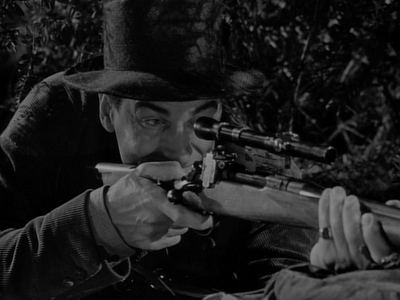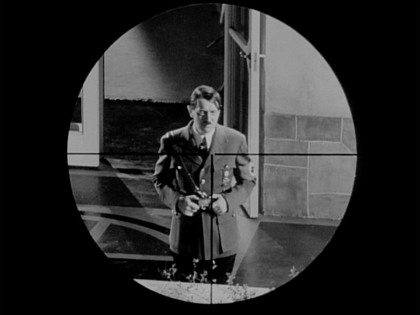From the Chicago Reader (May 6, 2002). — J.R.
Man Hunt
*** (A must-see)
Directed by Fritz Lang
Written by Dudley Nichols
With Walter Pidgeon, Joan Bennett, George Sanders, John Carradine, Roddy McDowall, Heather Thatcher, and Frederick Worlock.
A sparkling new 35-millimeter print of Fritz Lang’s 1941 Man Hunt is running at the Gene Siskel Film Center all this week, and I can recommend it without reservation. It’s not quite a masterpiece, but it’s considerably more entertaining than any new thrillers I’m aware of.
Man Hunt‘s status within Lang’s body of work is somewhat ambiguous and contested. Ten years ago one of France’s major film historians, Bernard Eisenschitz, wrote a 270-page book on the film in which he pored over many of the production materials as if they were holy writ. Yet Tom Gunning’s authoritative recent critical study, the 528-page The Films of Fritz Lang: Allegories of Vision and Modernity, scarcely deals with the film at all, apart from mentioning that it “would reward close analysis” and contending that it, like Lang’s three other anti-Nazi films — Hangmen Also Die! (1943), Ministry of Fear (1944), and Cloak and Dagger (1946) — is limited by its propagandistic qualities.
I only half agree with Gunning. He has a point when it comes to Man Hunt‘s simplistic, tub-thumping conclusion, yet this finale provides a precise and logical bookend to what might well be the most hair-raising opening of any Lang picture — which is equally propagandistic, though I wouldn’t trade it for anything that wasn’t. It’s also worth noting that Man Hunt, adapted from Geoffrey Household’s novel Rogue Male, is the only one of Lang’s anti-Nazi features made before America entered the war. (Cloak and Dagger, the only postwar item in the bunch, provides another kind of bookend to his reflections on Nazi mischief.)
Shooting started at 20th Century-Fox on March 12, 1941, and the movie premiered in New York only three months later, or almost half a year before Pearl Harbor. (It wouldn’t turn up in France for another eight years, and its first appearance in Germany was on East German TV in 1974.) The Hollywood of 61 years ago wasn’t just more efficient. Place Man Hunt alongside, say, Jonathan Demme’s new film, The Truth About Charlie, and you can see how this older, cheaper, black-and-white thriller comes out way ahead on every conceivable level: suspense, comedy, glamour, romance, characters, charm, atmosphere, and pacing, not to mention writing, acting, directing, cinematography, set design, music, and editing. Of course, back when his budgets and anticipated grosses were modest, Demme was a minor master, with pictures such as Handle With Care and Melvin and Howard. Some of the musical selections in The Truth About Charlie are a saving grace, but there’s nothing to match “A Nightingale Sang in Berkeley Square,” which is used tenderly in Man Hunt to evoke its plucky heroine.
Man Hunt was conceived and largely prepared as a project for John Ford to direct — until he, never interested anyway, backed out at the last minute. It uses one of Ford’s favorite screenwriters, the prestigious Dudley Nichols, who’d already written such Ford movies as Judge Priest, The Informer, Steamboat ‘Round the Bend, Mary of Scotland, The Hurricane, Stagecoach, and The Long Voyage Home. Nevertheless, this is very much a Lang film, one he managed to make both characteristic and personal. It even has a claustrophobic cave at the end and a map of London the Nazi villain uses to track the movements of the hero.
Man Hunt begins with a printed title: “Somewhere in Germany — shortly before the War.” The camera descends and moves forward, slowly and mysteriously, from the top of a misty forest through tree branches and down to eerily lit underbrush and footprints in the mud, which the camera then follows. This dissolves into a hunter (Walter Pidgeon) creeping stealthily through the brush to avoid a patrolling officer. Approaching a ledge, he crawls under a bush, looks through binoculars, and attaches a sight to his high-powered rifle. Through the crosshairs he sees Adolf Hitler chatting with an officer on an open terrace. After the officer departs, a close-up shows the hunter’s finger slowly squeeze the trigger. We hear a catch — the chamber is empty — and he laughs to himself and silently offers a mock salute in Hitler’s general direction. Then we see him insert a bullet, cock the rifle, and take aim again at Hitler, now alone and looking out from the balcony. The hunter is momentarily distracted by a falling leaf, and then the patrolling officer leaps on him and wrests away his rifle.
After this wordless existential prelude — a clear invitation to the viewer to identify with the hunter — you might imagine that the rest of the movie will be something of a letdown, and you wouldn’t be wrong. Nonetheless, it’s an absorbing and evocative thriller.
Next we watch the Nazi officer Hitler was just seen conversing with (George Sanders) inspecting the rifle and the British passport of the hunter, Alan Thorndike, and speaking almost exclusively in German to an associate and then to a couple of underlings on the phone. Once Thorndike is brought in, we discover from the dialogue, now in English, that he’s a famous big-game hunter, the brother of an English diplomat who visited the same house the previous year. He maintains that he had no intention of assassinating Hitler; he’s guilty only of what he calls a “sporting stalk” — a game to prove to himself for the fun of it that he could have shot him if he’d wanted to.
This may sound like a stretch — it certainly appears that way to the Nazi officer — yet most of the film appears to confirm his claim. After his capture Thorndike becomes the “man” of the title, hunted by the Nazis after escaping; during his incognito flight on a Danish steamer he’s assisted by a cabin boy (a winning and unaffected performance by Roddy McDowall in his first film role). The foggy London where most of the rest of the film is set — an astonishing studio re-creation that’s even more impressive than the German forest — is a quintessential Langian labyrinth. It incorporates an uncanny approximation of the London Underground, which figures in the taut chase sequence that serves as the film’s centerpiece. If the forest calls to mind Lang’s Nibelungen, this London is at least a second cousin to the city in M, where the realistic sets never entirely depart from a metaphysical sense of fantasy.
In London, Thorndike is helped by a streetwalker (wonderfully played by Joan Bennett, who would go on to star in three more Lang pictures). Lang evaded the studio censors by agreeing to add an absurd prop to her flat, a sewing machine; in the highly codified world of Hollywood, it presumably goes without saying that prostitutes don’t sew. Studio chief Darryl F. Zanuck refused to allow a sequence in which Bennett’s character actually behaves like a streetwalker until Lang shot it at his own expense after hours, assisted by only a couple of his crew members, and showed it to Zanuck for approval. Bennett’s best moments come in a hilarious encounter with Thorndike’s sister-in-law (Heather Thatcher) and in a poignant moment when she bursts into tears after discovering that Thorndike doesn’t want to sleep with her. Just as Lang adroitly used the sound of his own untranslated native language to frighten American audiences, he used Bennett’s cockney accent to create a warm pocket of coziness and safety at the center of a malevolent universe.
— Chicago Reader, December 6, 2002








